Structural Health Prediction Method for Pipelines Subjected to Seismic Liquefaction-Induced Displacement via FEM and AutoML
Abstract
1. Introduction
2. Experimental Investigation of Soil–Pipeline Interaction Under Seismic Loading
2.1. Soil–Pipeline Interaction Test Platform
2.2. Soil Parameters
2.3. Experimental Procedure and Analysis
2.4. Soil Spring Modification
3. Mechanical Response of Buried Pipelines Subjected to Seismic Liquefaction-Induced Displacement
3.1. Nonlinear Soil–Pipeline Interaction Model
3.2. Selection of Model and Computational Case Parameters
3.2.1. Pipeline Parameters
3.2.2. Soil Spring Parameters
3.2.3. Calculation Conditions
3.3. Liquefaction-Induced Displacement
4. Analysis of Influencing Factors on Pipeline Mechanical Response
4.1. Length of Liquefaction Zone
4.2. Seismic Wave Frequency
4.3. Internal Pipe Pressure
4.4. Pipe Wall Thickness
5. The Intelligent Prediction of Pipeline Structural Safety Under Seismic Liquefaction-Induced Displacement
5.1. Database Construction
5.2. Machine Learning Algorithms
5.3. Intelligent Prediction Model Training for Pipeline Structural Safety State
5.4. Validation and Comparison of Multiple Models for the Intelligent Prediction of Pipeline Structural Safety State
5.5. Model Interpretability Analysis Based on SHAP
6. Conclusions
- (1)
- Based on the original soil spring calculation formula from ASCE-ALA (2001), we established a solution formula for lateral ultimate soil resistance applicable to 0–5 Hz seismic frequencies under typical clay conditions along the China–Russia Eastern Pipeline route through physical experiments, obtaining modified soil spring coefficients for different frequency ranges.
- (2)
- This study developed a finite element numerical simulation model of pipe–soil interaction under liquefaction-induced displacement based on modified soil springs. The investigation elucidated the axial strain distribution patterns and extreme strain evolution characteristics on both the active and passive sides of pipelines under varying conditions including liquefaction zone length, seismic wave frequency, internal pipeline pressure, and pipe wall thickness. Subsequently, a comprehensive database of maximum and minimum pipeline strains was established.
- (3)
- The validated optimal prediction model for pipeline safety under seismic liquefaction-induced displacement demonstrates outstanding performance in predicting axial strain peaks, with R2 and MAPE values of 0.99975 and 0.96071% for passive side maximum axial strain, 0.99974 and 0.54622% for passive side minimum axial strain, 0.99988 and 0.71701% for active side maximum axial strain, and 0.99988 and 0.53409% for active side minimum axial strain, respectively. These results confirm the model’s high accuracy in predicting pipeline strain extremes caused by liquefaction displacement. SHAP-based interpretability analysis is also performed on the developed model. The results indicate that liquefaction-induced displacement is the most critical factor affecting the maximum and minimum axial strains on both the upslope and downslope sides of the pipeline under seismic liquefaction. Additionally, increasing the pipeline wall thickness can effectively mitigate deformation caused by liquefaction.
- (4)
- The model’s performance is contingent on the validity of the underlying FEM simulations and experimental data, primarily applicable to clayey soils and the specific displacement pattern used. Generalization to sandy liquefiable soils, complex 3D ground motion, or different pipeline configurations requires further validation.
- (5)
- Future research should focus on: (a) validating the model against field case studies or centrifuge test data, (b) extending the approach to sandy liquefiable soils, (c) incorporating spatial variability of ground motion and soil properties, and (d) exploring the integration of real-time sensor data for online model updating and prognostics.
Author Contributions
Funding
Data Availability Statement
Conflicts of Interest
References
- EI Hmadi, K.; O’Rourke, M.J. Soil Springs for Buried Pipeline Axial Motion. J. Geotech. Eng. ASCE 1988, 114, 1335–1339. [Google Scholar] [CrossRef]
- Guo, E.D.; Feng, Q.M. Aseismic Analysis Method for Buried Steel Pipe Crossing Fault. Earthq. Eng. Eng. Vib. 1999, 19, 43–47. [Google Scholar]
- Feng, Q.M.; Guo, E.D. Seismic Performance Testing of Pipeline Structures Crossing Active Faults. Earthq. Eng. Eng. Vib. 2000, 20, 56–63. [Google Scholar]
- Hindy, A.; Novak, M. Earthquake response of under ground pipeline. Int. J. Earthq. Eng. Struct. Dyn. 1979, 7, 451–476. [Google Scholar] [CrossRef]
- Xu, J.C.; Jian, W.B.; Shang, Y.Q. Study on the Seismic Failure Mechanism of the Thick Soft Soil Foundation. Chin. J. Rock Mech. Eng. 2005, 24, 313–320. [Google Scholar]
- Madabhushi, S.; Madabhushi, S. Finite Element Analysis of Floatation of Rectangular Tunnels Following Earthquake Induced Liquefaction. Indian Geotech. J. 2014, 45, 233–242. [Google Scholar] [CrossRef]
- Azadi, M.; Hosseini, S.M.M.M. The uplifting behavior of shallow tunnels within the liquefiable soils under cyclic loading. Tunn. Undergr. Space Technol. 2010, 25, 158–167. [Google Scholar] [CrossRef]
- Tang, A.P.; Li, Z.Q.; Feng, R.C.; Zhou, X.Y. Model Experiment and Analysis on Seismic Response of Utility Tunnel Systems Using a Shaking Table. Chin. J. Rock Mech. Eng. 2009, 41, 1–5. [Google Scholar]
- American Lifelines Alliance—American Society of Civil Engineers. Guidelines for the Design of Buried Steel Pipe (with Addenda through February 2005). 2001. Available online: https://www.americanlifelinesalliance.com/pdf/Update061305.pdf (accessed on 1 May 2025).
- Saeedzadeh, R.; Hataf, N. Uplift response of buried pipelines in saturated sand deposit under earthquake loading. Soil Dyn. Earthq. Eng. 2011, 31, 1378–1384. [Google Scholar] [CrossRef]
- Yan, K.; Zhang, J.; Wang, Z.; Liao, W.; Wu, Z. Seismic responses of deep buried pipeline under non-uniform excitations from large scale shaking table test. Soil Dyn. Earthq. Eng. 2018, 113, 180–192. [Google Scholar] [CrossRef]
- ABAQUS. ABAQUS User’s Manual, version 6.11.; Simulia: Providence, RI, USA, 2011. [Google Scholar]
- GB50470-2017; Seismic Technical Code for Oil and Gas Transmission Pipeline Engineering. China Planning Press: Beijing, China, 2017.
- O’Rourke, M.J.; Liu, X. Seismic Design of Buried and Offshore Pipelines; MCEER-12-MN04; University at Buffalo, State University of New York: Buffalo, NY, USA, 2012; p. 158. [Google Scholar]
- Feurer, M.; Eggensperger, K.; Falkner, S.; Lindauer, M.; Hutter, F. Auto-sklearn 2.0: Hands-free automl via meta-learning. J. Mach. Learn. Res. 2022, 23, 1–61. [Google Scholar]
- Feurer, M.; Klein, A.; Eggensperger, K.; Springenberg, J.; Blum, M.; Hutter, F. Efficient and robust automated machine learning. Adv. Neural Inf. Process. Syst. 2015, 28. [Google Scholar]
- Wang., C.; Wu, Q.; Weimer, M.; Zhu, E. FLAML: A Fast and Lightweight AutoML Library. Proc. Mach. Learn. Syst. 2021, 3, 434–447. [Google Scholar]
- Ke, G.; Meng, Q.; Finley, T.; Wang, T.; Chen, W.; Ma, W.; Ye, Q.; Liu, T.-Y. Lightgbm: A highly efficient gradient boosting decision tree. Adv. Neural Inf. Process. Syst. 2017, 30. [Google Scholar]
- Shakeel, A.; Chong, D.; Wang, J. District heating load forecasting with a hybrid model based on LightGBM and FB-prophet. J. Clean. Prod. 2023, 409, 137130. [Google Scholar] [CrossRef]
- Chen, T.; Guestrin, C. Xgboost: A Scalable Tree Boosting System. In Proceedings of the 22nd ACM SIGKDD International Conference on Knowledge Discovery and Data Mining, San Francisco, CA, USA, 13–17 August 2016; pp. 785–794. [Google Scholar]
- Zhou, S. Gwo-ga-xgboost-based model for Radio-Frequency power amplifier under different temperatures. Expert Syst. Appl. 2025, 278, 127439. [Google Scholar] [CrossRef]
- Prokhorenkova, L.; Gusev, G.; Vorobev, A.; Dorogush, A.V.; Gulin, A. CatBoost: Unbiased boosting with categorical features. Adv. Neural Inf. Process. Syst. 2018, 31. [Google Scholar]
- Fan, Z.; Gou, J.; Weng, S. Complementary CatBoost based on residual error for student performance prediction. Pattern Recognit. 2025, 161, 111265. [Google Scholar] [CrossRef]
- Peng, H.; Lu, H.; Xu, Z.-D.; Wang, Y.; Zhang, Z. Predicting Solid-Particle Erosion Rate of Pipelines Using Support Vector Machine with Improved Sparrow Search Algorithm. J. Pipeline Syst. Eng. Pract. 2023, 14, 04022077. [Google Scholar] [CrossRef]
- Lu, H.; Iseley, T.; Matthews, J.; Liao, W. Hybrid machine learning for pullback force forecasting during horizontal directional drilling. Autom. Constr. 2021, 129, 103810. [Google Scholar] [CrossRef]
- Lundberg, S.M.; Lee, S.I. A unified approach to interpreting model predictions. Adv. Neural Inf. Process. Syst. 2017, 30. [Google Scholar]
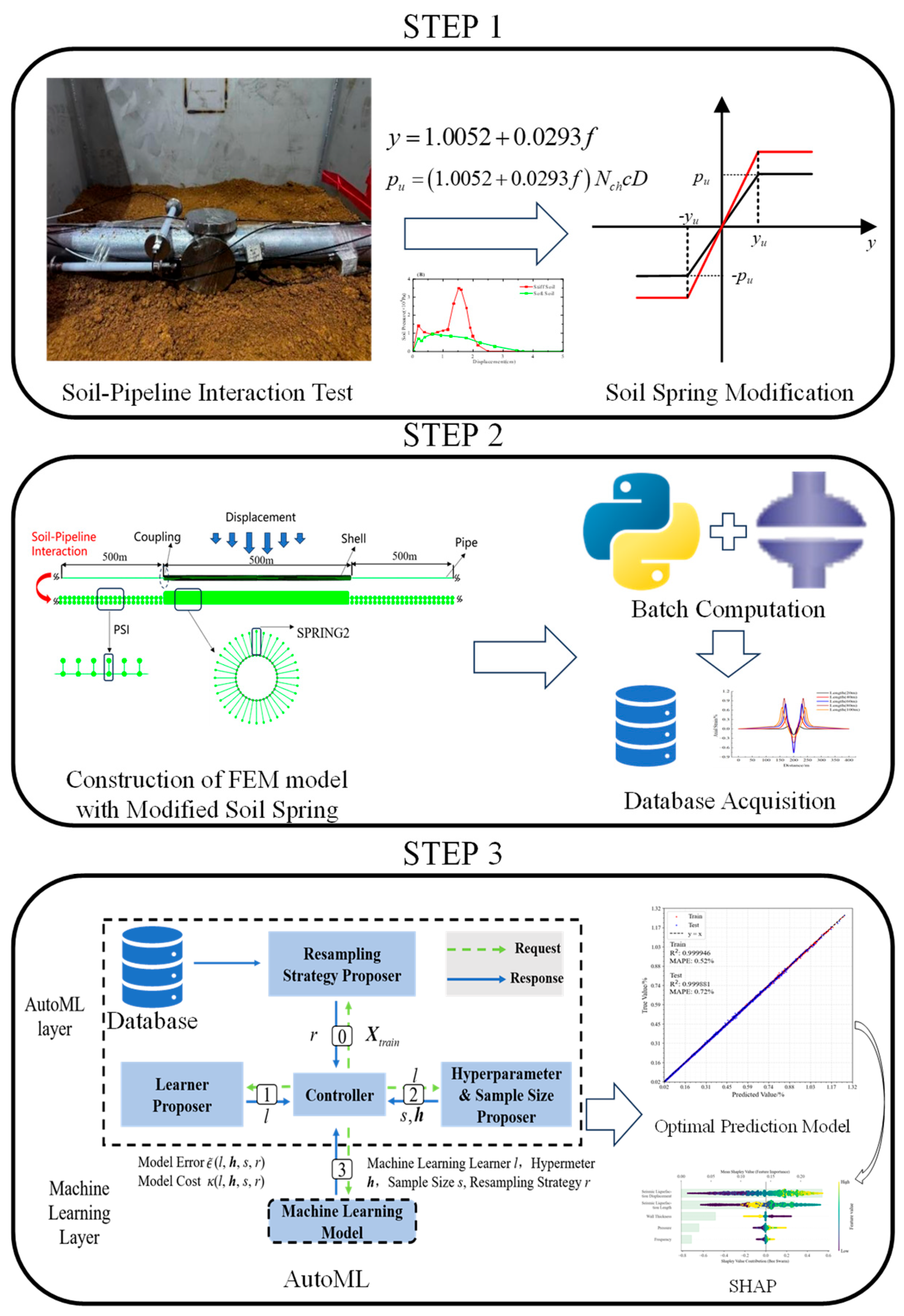
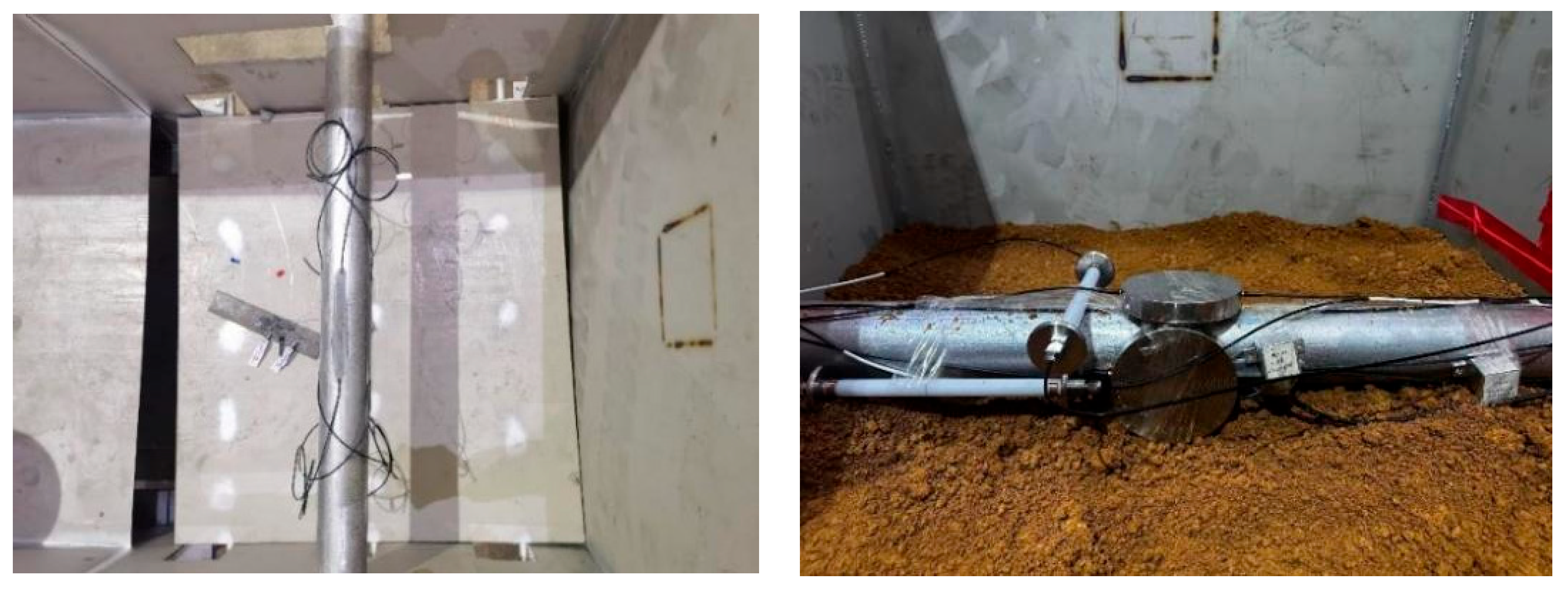
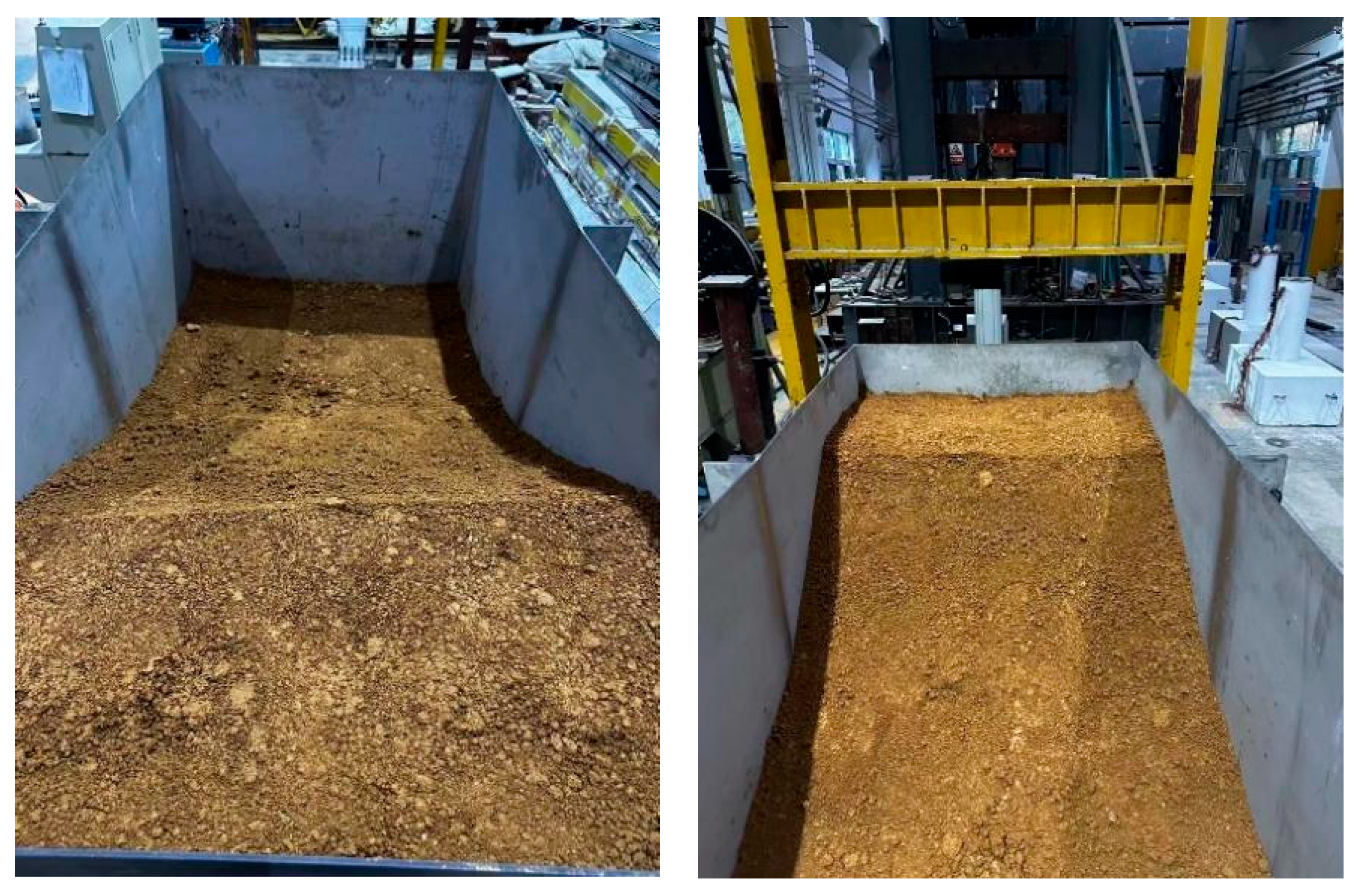


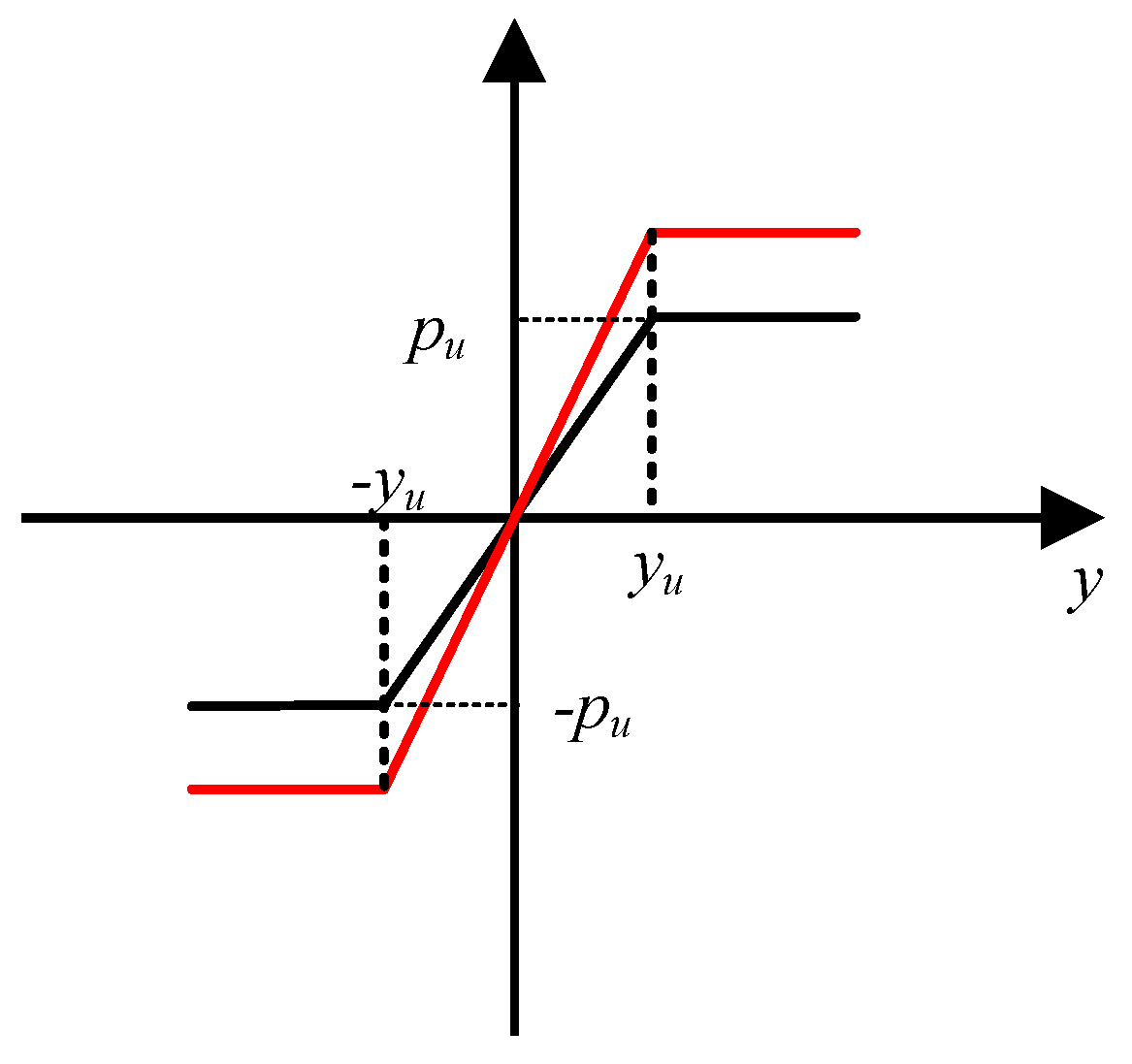

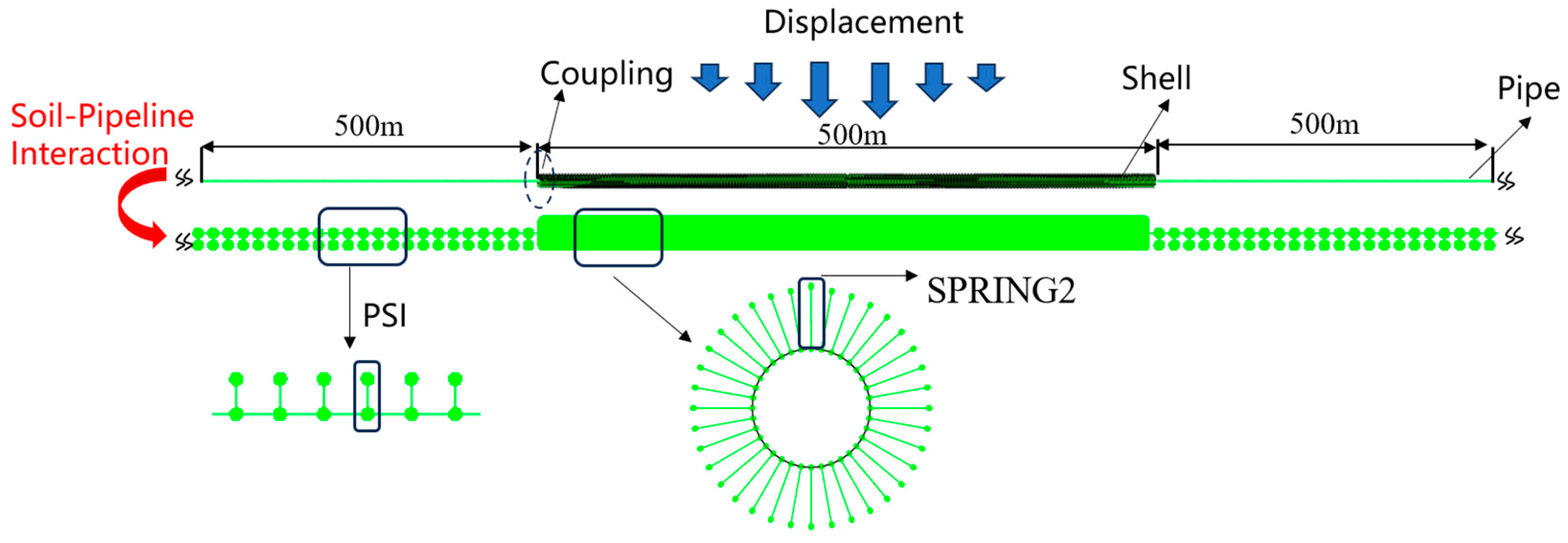

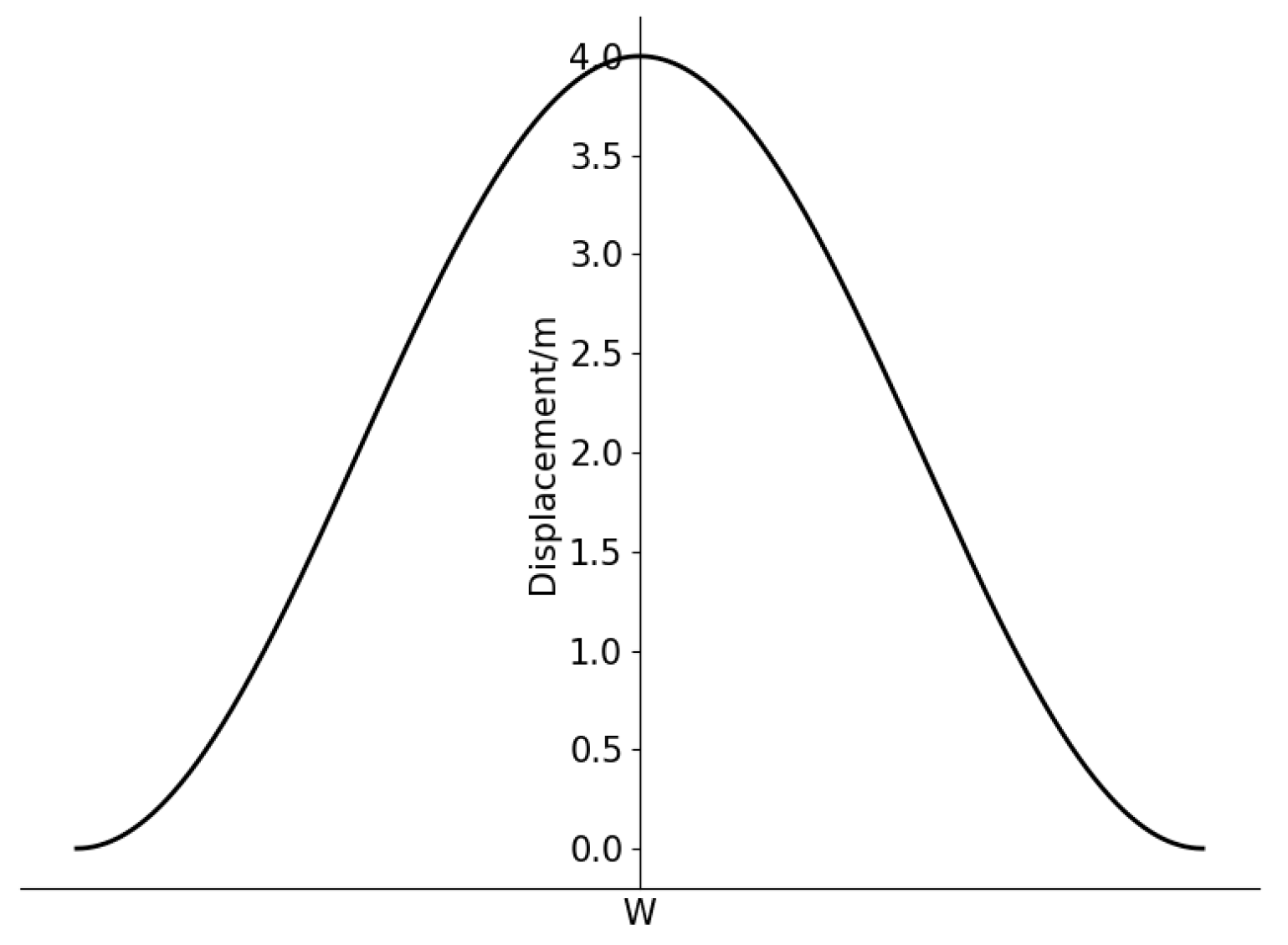

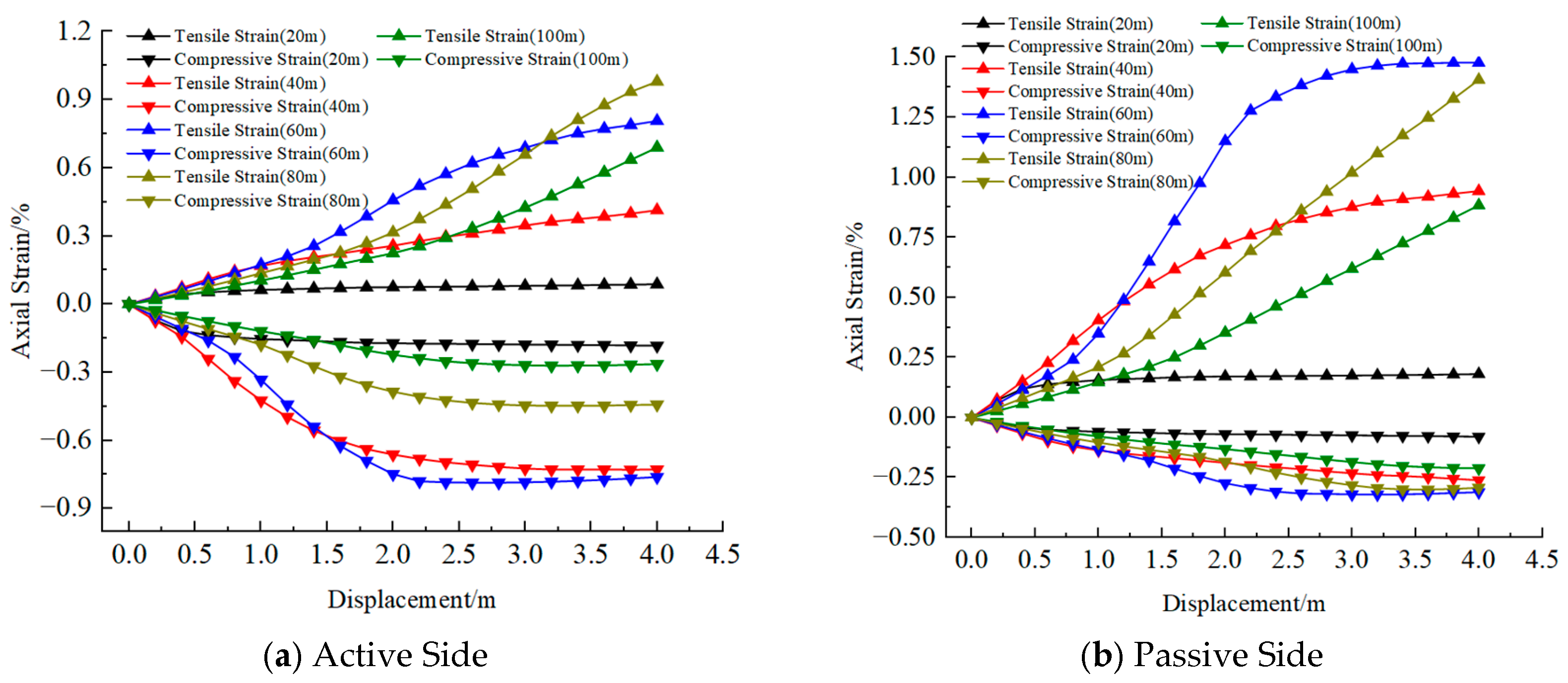
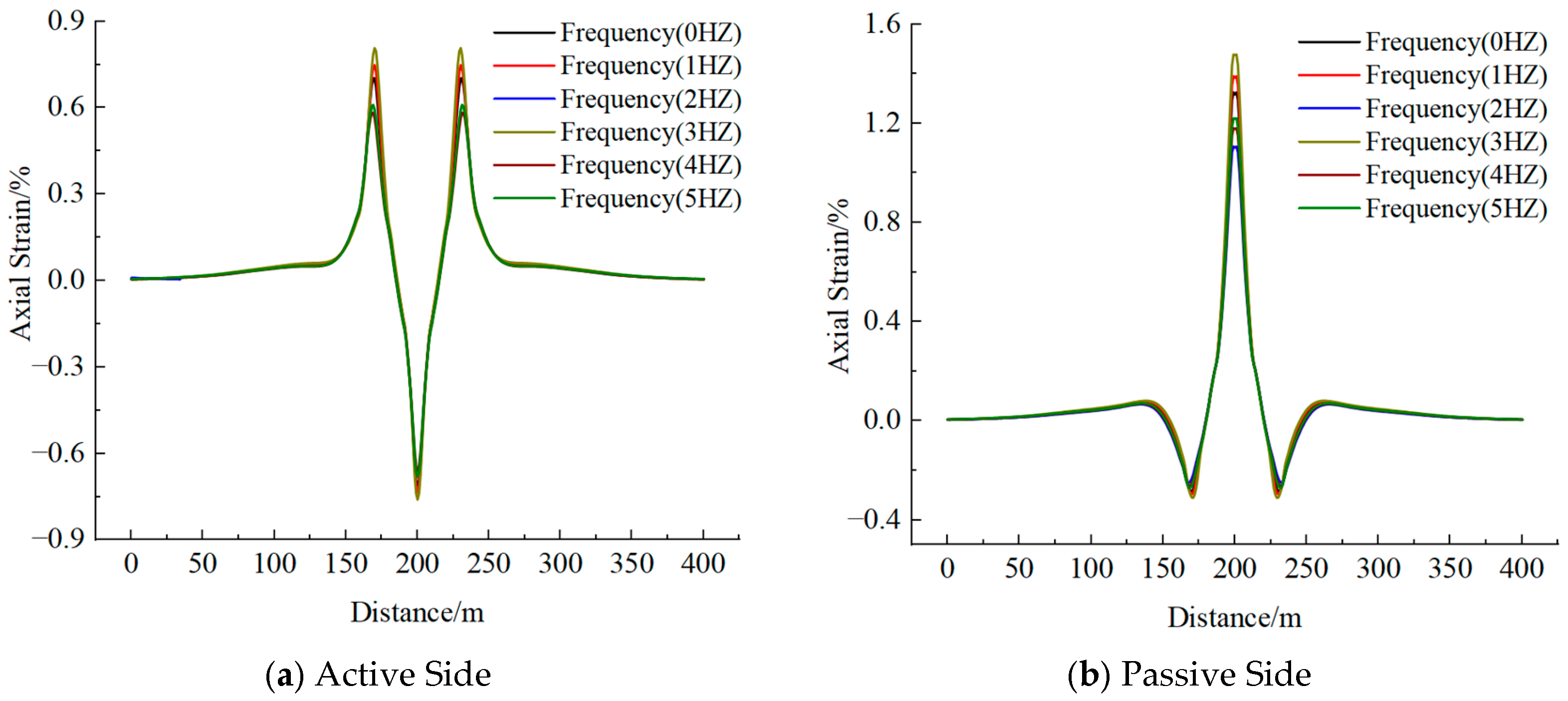
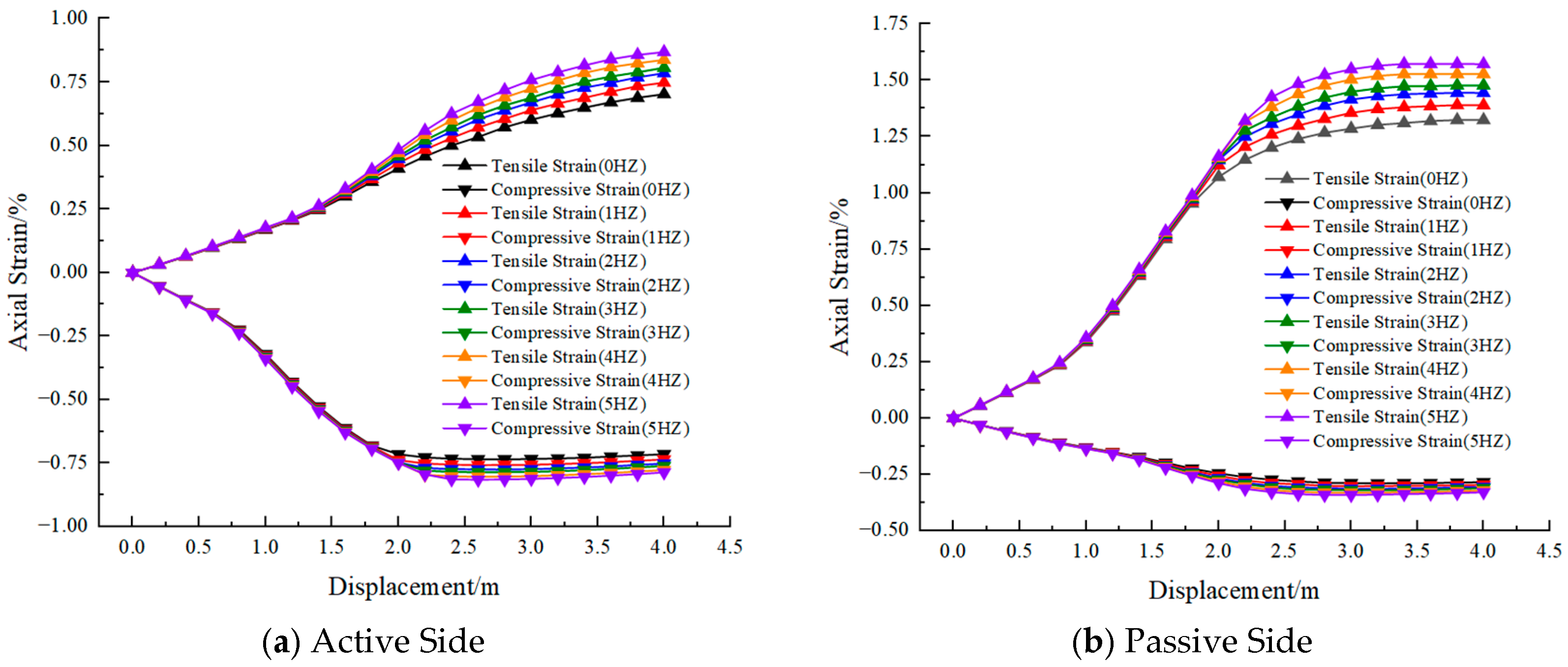

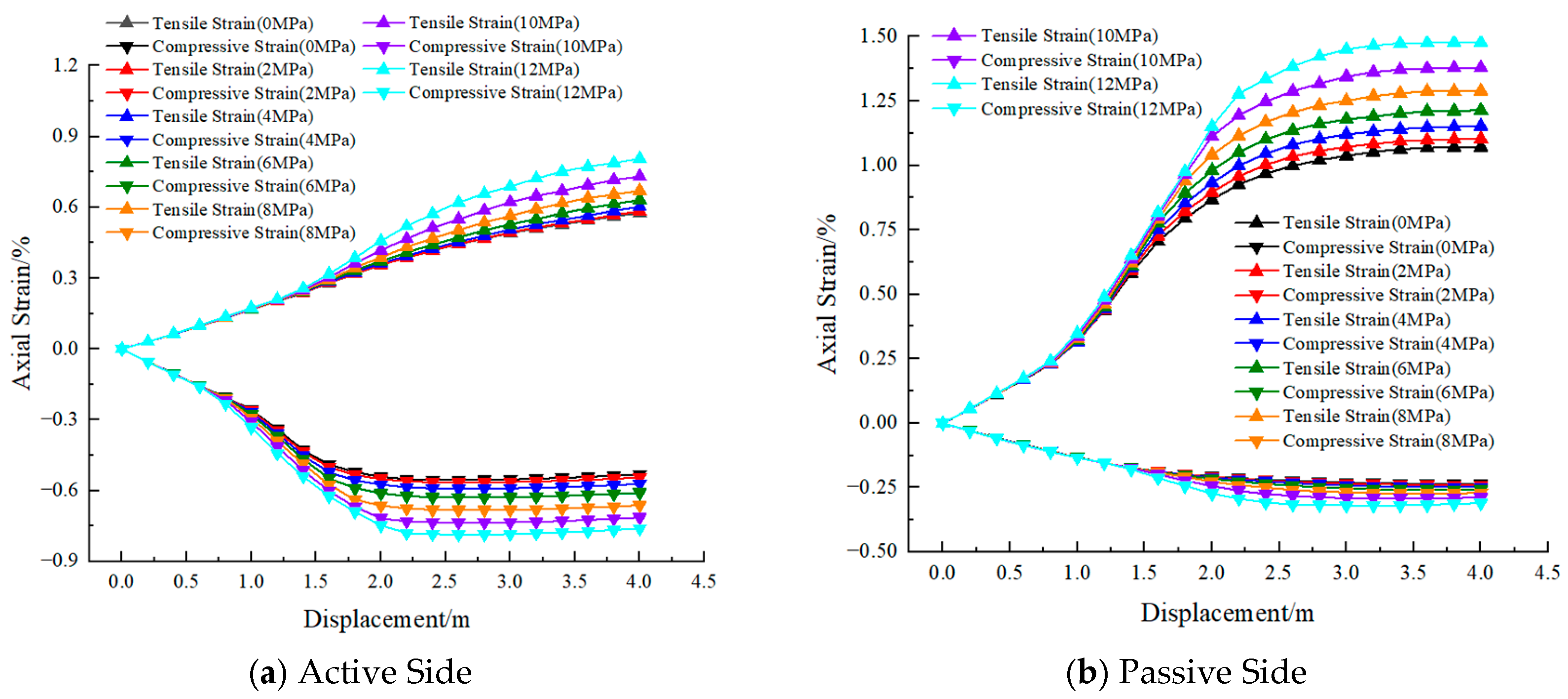

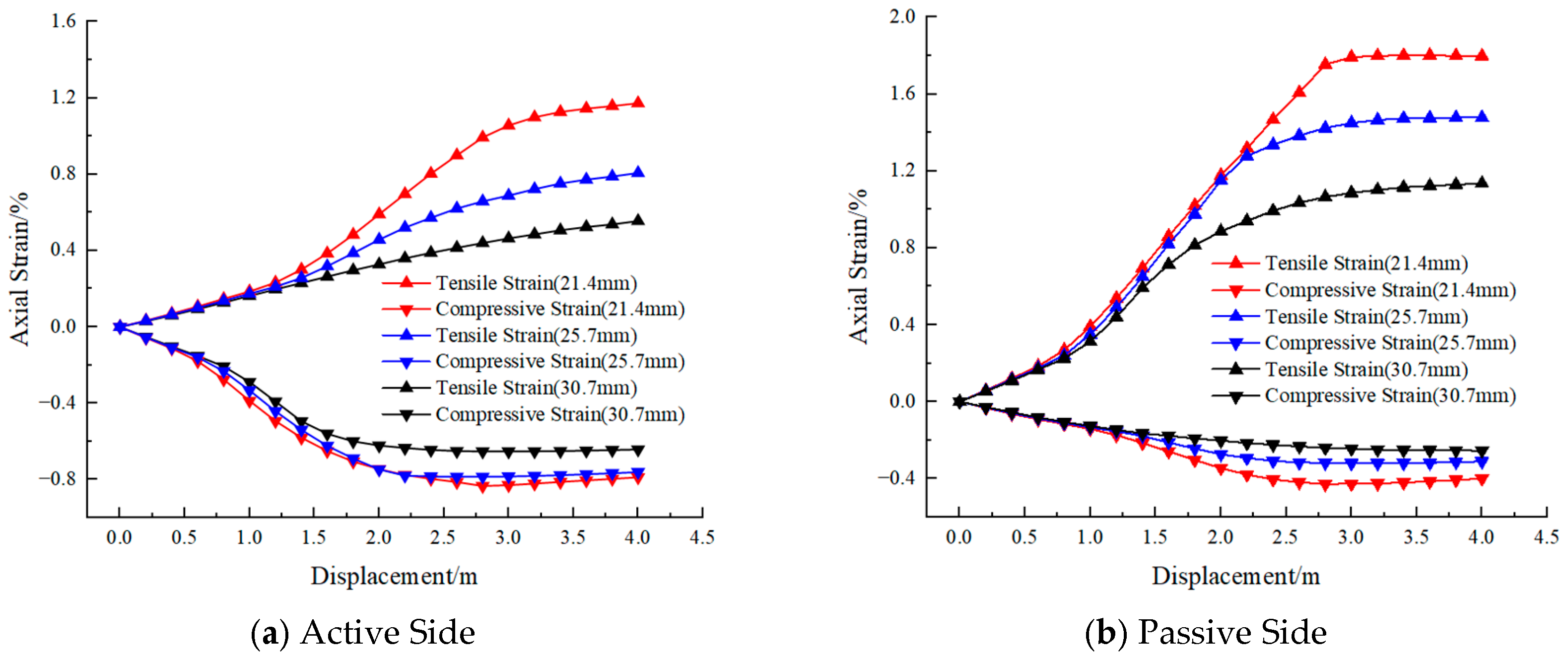
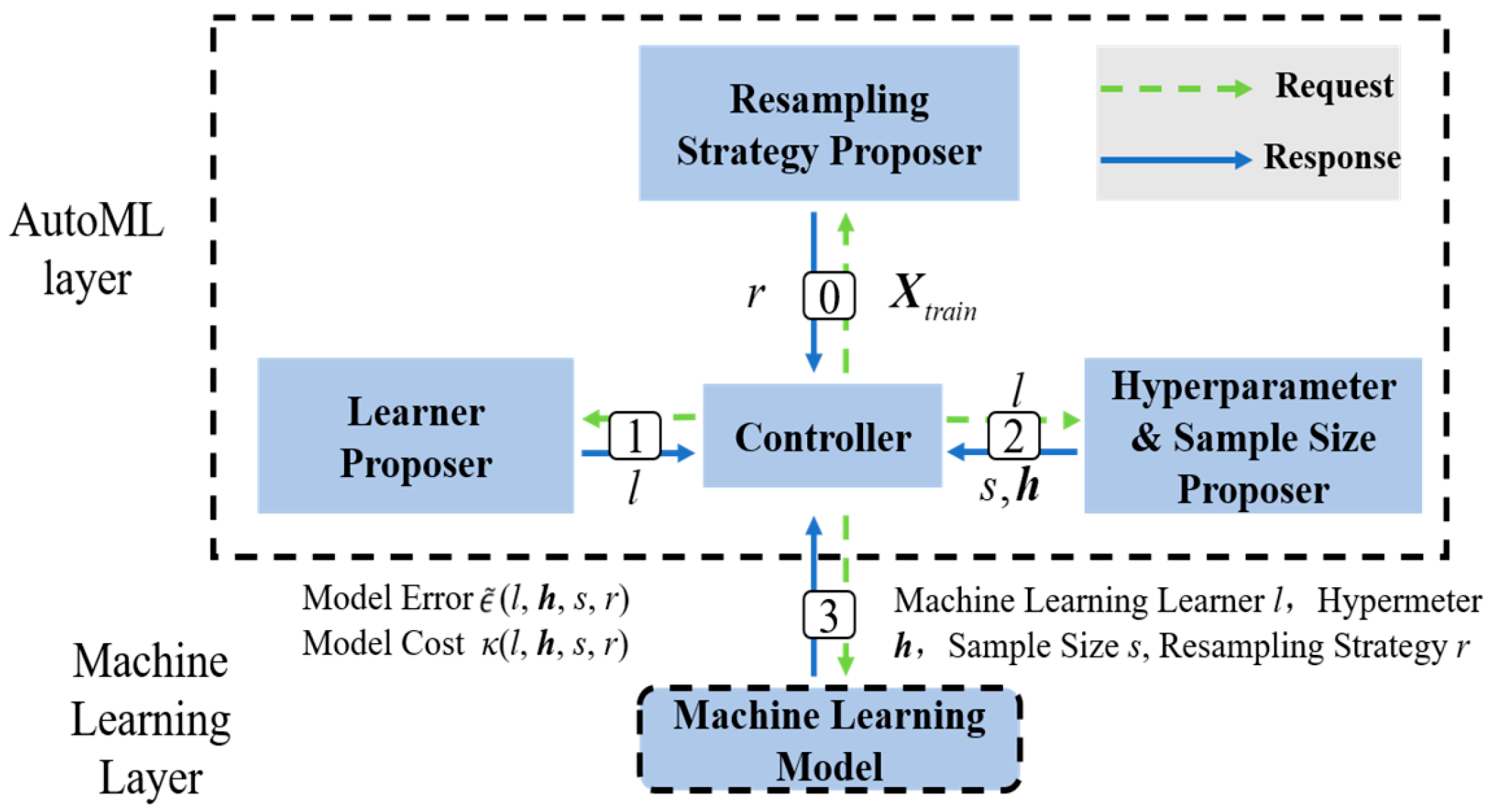

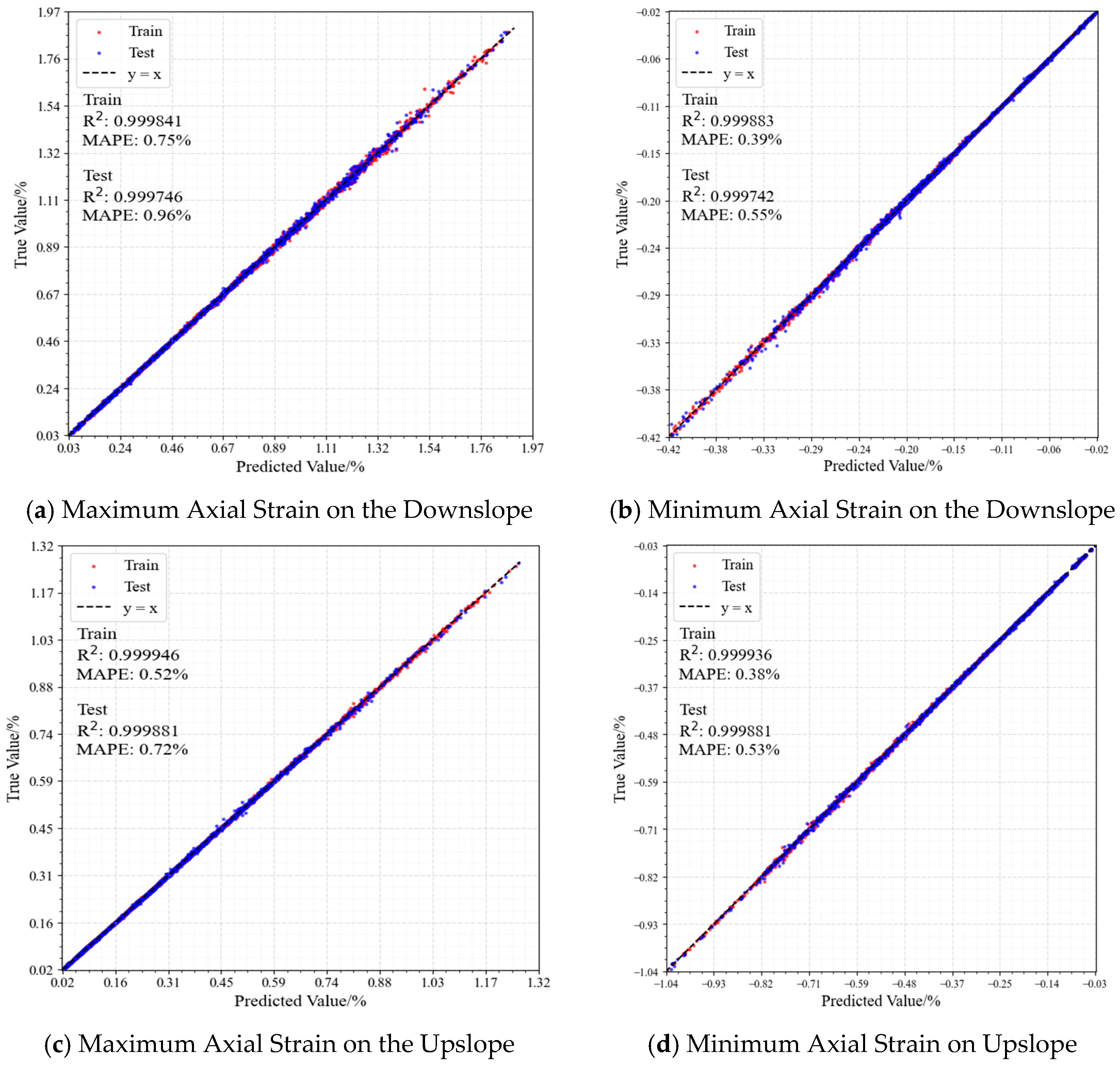
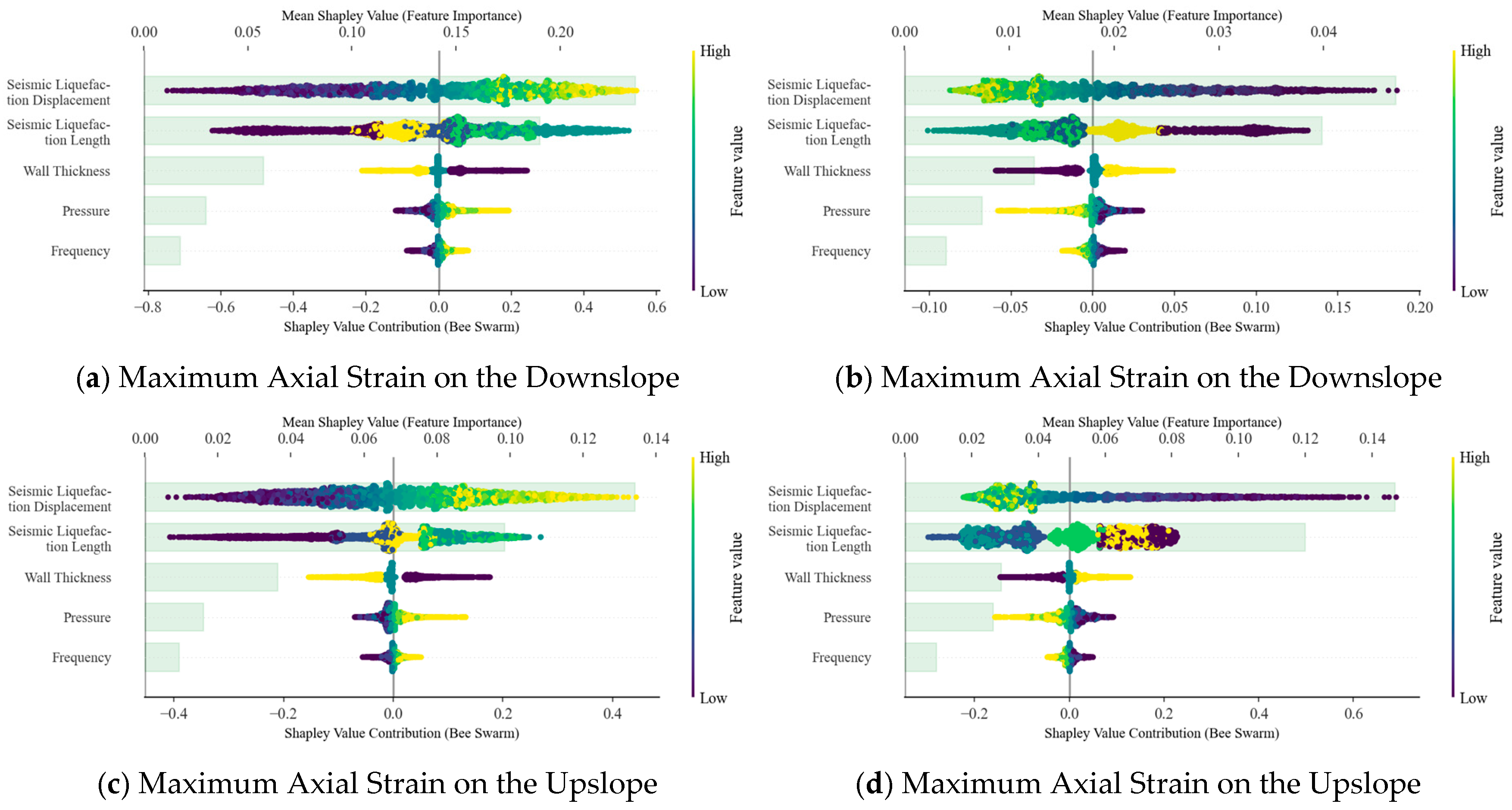
| Soil Sample | Density/(kg/m3) | Cohesion/KPa | Internal Friction Angle/° |
|---|---|---|---|
| Soft Clay | 1531 | 34 | 22.5 |
| Stiff Clay | 2100 | 44 | 27.0 |
| Frequency (Hz) | Relative Amplification Factor |
|---|---|
| 0 | 1.0 |
| 1 | 1.0376 |
| 2 | 1.0702 |
| 3 | 1.0901 |
| 4 | 1.1216 |
| 5 | 1.1505 |
| Frequency | Lateral Soil Springs | |
|---|---|---|
| Soil Force/(kN/m) | Ultimate Displacement/mm | |
| 0 HZ | 285.1 | 140.4 |
| 1 HZ | 295.8 | 140.4 |
| 2 HZ | 305.1 | 140.4 |
| 3 HZ | 310.8 | 140.4 |
| 4 HZ | 319.8 | 140.4 |
| 5 HZ | 328.0 | 140.4 |
| Names | |||
|---|---|---|---|
| Length of Liquefaction Zone (m) | Seismic Wave Frequency (Hz) | Internal Pipe Pressure (MPa) | Pipe Wall Thickness (mm) |
| 20 | 0 | 0 | 21.4 |
| 40 | 1 | 2 | 25.7 |
| 60 | 2 | 4 | 30.7 |
| 80 | 3 | 6 | |
| 100 | 4 | 8 | |
| 5 | 10 | ||
| 12 | |||
| Pipe Diameter/mm | Wall Thickness/mm | Seismic Liquefaction Length/m | Pressure/MPa | Frequency/Hz | Seismic Liquefaction Displacement/m |
|---|---|---|---|---|---|
| 1422 | 21.4, 25.7, 30.7 | 20, 40, 60, 80, 100 | 0~12 | 0~5 | 0~4.0 |
| Model | R2 | R | MSE | RMSE | MAPE/% |
|---|---|---|---|---|---|
| LightGBM | 0.99967 | 0.99983 | 0.00005 | 0.00722 | 0.85459 |
| XGBoost | 0.99942 | 0.99971 | 0.00009 | 0.00953 | 2.30461 |
| CatBoost | 0.99975 | 0.99987 | 0.00004 | 0.00632 | 0.96071 |
| Model | R2 | R | MSE | RMSE | MAPE/% |
|---|---|---|---|---|---|
| LightGBM | 0.99946 | 0.99973 | 0.00000 | 0.00187 | 0.65893 |
| XGBoost | 0.99633 | 0.99817 | 0.00002 | 0.00486 | 3.59350 |
| CatBoost | 0.99974 | 0.99987 | 0.00000 | 0.00129 | 0.54622 |
| Model | R2 | R | MSE | RMSE | MAPE/% |
|---|---|---|---|---|---|
| LightGBM | 0.99953 | 0.99977 | 0.00002 | 0.00485 | 1.22723 |
| XGBoost | 0.99927 | 0.99964 | 0.00004 | 0.00604 | 2.32964 |
| CatBoost | 0.99988 | 0.99994 | 0.00001 | 0.00244 | 0.71701 |
| Model | R2 | R | MSE | RMSE | MAPE/% |
|---|---|---|---|---|---|
| LightGBM | 0.99975 | 0.99987 | 0.00001 | 0.00318 | 0.46961 |
| XGBoost | 0.99960 | 0.99980 | 0.00002 | 0.00398 | 0.72459 |
| CatBoost | 0.99988 | 0.99994 | 0.00000 | 0.00218 | 0.53409 |
Disclaimer/Publisher’s Note: The statements, opinions and data contained in all publications are solely those of the individual author(s) and contributor(s) and not of MDPI and/or the editor(s). MDPI and/or the editor(s) disclaim responsibility for any injury to people or property resulting from any ideas, methods, instructions or products referred to in the content. |
© 2025 by the authors. Licensee MDPI, Basel, Switzerland. This article is an open access article distributed under the terms and conditions of the Creative Commons Attribution (CC BY) license (https://creativecommons.org/licenses/by/4.0/).
Share and Cite
Shi, N.; Kong, T.; Ding, W.; Zheng, X.; Zhang, H.; Liu, X. Structural Health Prediction Method for Pipelines Subjected to Seismic Liquefaction-Induced Displacement via FEM and AutoML. Processes 2025, 13, 2163. https://doi.org/10.3390/pr13072163
Shi N, Kong T, Ding W, Zheng X, Zhang H, Liu X. Structural Health Prediction Method for Pipelines Subjected to Seismic Liquefaction-Induced Displacement via FEM and AutoML. Processes. 2025; 13(7):2163. https://doi.org/10.3390/pr13072163
Chicago/Turabian StyleShi, Ning, Tianwei Kong, Wancheng Ding, Xianbin Zheng, Hong Zhang, and Xiaoben Liu. 2025. "Structural Health Prediction Method for Pipelines Subjected to Seismic Liquefaction-Induced Displacement via FEM and AutoML" Processes 13, no. 7: 2163. https://doi.org/10.3390/pr13072163
APA StyleShi, N., Kong, T., Ding, W., Zheng, X., Zhang, H., & Liu, X. (2025). Structural Health Prediction Method for Pipelines Subjected to Seismic Liquefaction-Induced Displacement via FEM and AutoML. Processes, 13(7), 2163. https://doi.org/10.3390/pr13072163







